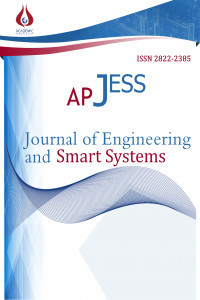Emotion Detection with n-stage Latent Dirichlet Allocation for Turkish Tweets
Topic Modeling, Latent Dirichlet Allocation, Natural Language Processing, Emotion Analysis
Emotion Detection with n-stage Latent Dirichlet Allocation for Turkish Tweets
Topic Modeling, Latent Dirichlet Allocation, Natural Language Processing, Emotion Analysis,
___
- [1] D. M. Blei, “Probabilistic topic models”, Communications of the ACM, vol. 55, no 4, pp. 77-84, April 2012.
- [2] A. Daud, J. Li, L. Zhou, and F. Muhammad, “Knowledge discovery through directed probabilistic topic models: a survey”, Frontiers of Compute rScience in Chine, vol. 4, no 2, pp. 280-301, June 2010.
- [3] M. Steyvers and T. Griffiths, “Probabilistic topic models”, Handbook of latent semantic analysis, vol. 427, no 7, pp. 424-440, February 2007.
- [4] B. Liu and L. Zhang, “A survey of opinion mining and sentiment analysis”, Mining text data, pp. 415-463, 2012.
- [5] O. Coban, B. Ozyer, and G. T. Ozyer, “Sentiment analysis for Turkish Twitter feeds,” 2015 23nd Signal Processing and Communications Applications Conference (SIU), May 2015.
- [6] H. Türkmen, S. I. Omurca, E. Ekinci,“An Aspect Based Sentiment Analysis on Turkish Hotel Reviews”, Girne American University Journal of Social and Applied Sciences, vol. 6, pp. 9-15, 2016.
- [7] K. Roberts, M. Roach, J. Johnson, J. Guthrie, and S. Harabagiu, “EmpaTweet: Annotating and Detecting Emotions on Twitter”, In Proceedings of the 8th International Conference on Language Resourcesand Evaluation (LREC), May 2012.
- [8] A. Çelikyılmaz, G. Tur, and D. Tur, “LDA Based Similarity Modeling for Question Answering”, Proceedings of the NAACL HLT 2010 Workshop on Semantic Search, pp. 1-9, May 2010.
- [9] G. Tur, A. Celikyilmaz, and D. Hakkani-Tur, “Latent semantic modeling for slot filling in conversational understanding,” 2013 IEEE International Conference on Acoustics, Speech and Signal Processing, May 2013.
- [10] P. Paroubek and A. Pak, “Twitter as a Corpus for Sentiment Analysis and Opinion Mining”, Proceedings of the International Conference on Language Resourcesand Evaluation, pp. 17-23, Malta, May 2010.
- [11] C. Lin and Y. He, “Joint sentiment/topic model for sentiment analysis,” Proceeding of the 18th ACM conference on Information and knowledge management - CIKM 09, pp. 375–384, Nov. 2009.
- [12] R. Chatterjee and S. Agarwal, “Twitter Truths: Authenticating Analysis of Information Credibility”, 2016 3rd International Conference on Computing for Sustainable Global Development, March 2016.
- [13] A. Ratku, S. Feuerriegel, and D. Neumann, “Analysis of How Underlying Topics in Financial News Affect Stock Prices Using Latent Dirichlet Allocation,” SSRN Electronic Journal, pp. 1072–1081, Jan. 2014.
- [14] C. Strapparava and R. Mihalcea, “SemEval-2007 task 14,” Proceedings of the 4th International Workshop on Semantic Evaluations - SemEval 07, pp. 70–74, Jun. 2007.
- [15] F. Colace, M. D. Santo, and L. Greco, “A Probabilistic Approach to Tweets Sentiment Classification,” 2013 Humaine Association Conference on Affective Computing and Intelligent Interaction, pp. 37–42, Sep. 2013.
- [16] A. Onan, “Türkçe Twitter Mesajlarında Gizli Dirichlet Tahsisine Dayalı Duygu Analizi”, Akademik Bilişim Konferansı, Feb. 2017.
- [17] D. M. Blei, A. Y. Ng, and M. I. Jordan, “Latent Dirichlet Allocation”, Journal of Machine Learning Research, vol. 3, pp. 993-1022, March 2003.
- [18] L. Bolelli, Ş. Ertekin, and C. L. Giles, “Topic and Trend Detection in Text Collections Using Latent Dirichlet Allocation,” Lecture Notes in Computer Science Advances in Information Retrieval, pp. 776–780, Apr. 2009.
- [19] J. Barber, “Latent Dirichlet Allocation (LDA) with Python,” Human Activity Recognition Using Smartphones Data Set. [Online]. Available: https://rstudio-pubs-static.s3.amazonaws.com/79360_850b2a69980c4488b1db95987a24867a.html. [Accessed: 12-Sep-2017].
- [20] wikizero.net. [Online]. Available: http://www.wikizero.net/index.php?q=aHR0cHM6Ly9lbi53aWtpcGVkaWEub3JnL3dpa2kvTGF0ZW50X0RpcmljaGxldF9hbGxvY2F0aW9u. [Accessed: 20-Oct-2017].
- [21] “Zemberek NLP,” Zemberek NLP. [Online]. Available: http://zembereknlp.blogspot.com/. [Accessed: 05-Oct-2017].
- [22] “Download,” Snowball. [Online]. Available: http://snowball.tartarus.org/download.html. [Accessed: 16-Nov-2017].
- Yayın Aralığı: Yılda 3 Sayı
- Başlangıç: 2022
- Yayıncı: Akademik Perspektif Derneği
Serbest Nilpotent Lie Cebirlerinin Otomorfizm Grupları Üzerine
Membran Kapasitif Deiyonizasyon Prosesi ile Sertlik Giderimi
Halil İbrahim UZUN, Eyüp DEBİK
Demiryolu Akslarının Ultrasonik Muayene Yöntemi Ve Phased Array Yöntemi İle Tahribatsız Muayenesi
Yıldız YARALI ÖZBEK, Serhan EMRE
Figen ÖZBOZ, Seda ULU, Abdülkadir AKYOL, Mehmet UYSAL, Harun GÜL, Ahmet ALP, Ali Osman AYDIN
Akın ÖZÇİFT, Deniz KILINÇ, Fatma BOZYİĞİT
Abdülkadir AKYOL, Hasan ALGÜL, Oğuzhan BİLAÇ, Seda ULU, Harun GÜL, Mehmet UYSAL, Yusuf ÇAY, Ahmet ALP
Y2O3 ve Er2O3-katkılı α/β/-SiAlON Seramiklerinin Oksidasyon Davranışları
Ancient Karez System in Afghanistan: The Perspective of Construction and Maintenance
Ayasofya Müzesi Zemin Yüzey Deformasyonlarının Yeraltı Radarı (GPR) İle İncelenmesi
Efecan BELCE, Tolga BEKLER, Yunus Can KURBAN, Cahit Çağlar YALÇINER
